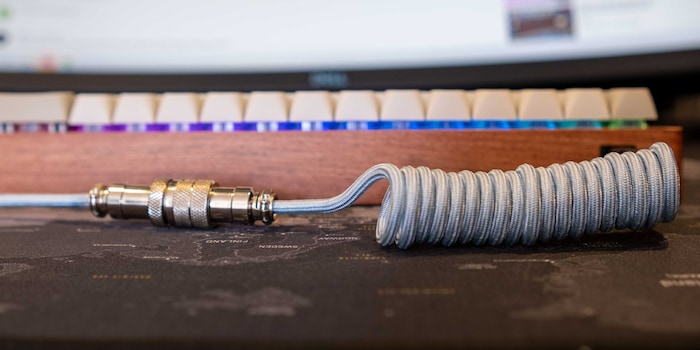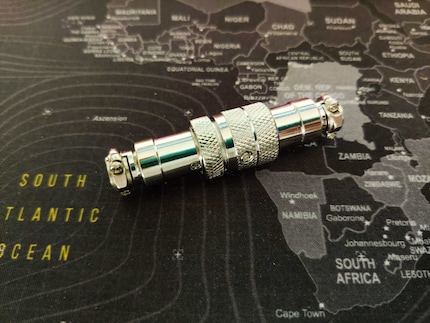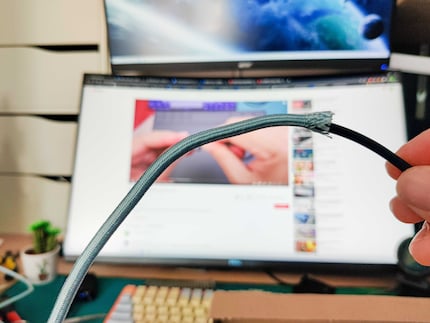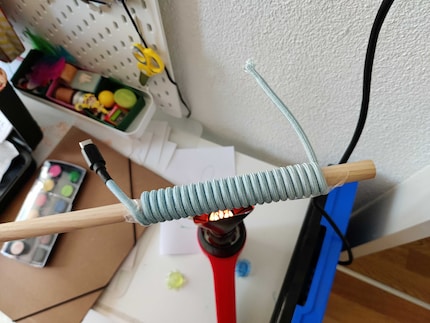
Guide
Thank you, Community! How you helped me tidy my desk
by Lorenz Keller

Cables aren’t sexy – unless they’re coiled cables, which ooze retro charm. I’m a big fan and make my own.
I recently gave my DIY keyboard a facelift. While an anonymous reader did really like my keyboard, they were more interested in something else on my desk.
…But the best bit is the coiled cable with the connector. It’s not a USB or some other kind of keyboard connector plug (PS/2)... Can you tell us what you’ve installed – or is that a separate blog episode?
To answer your question: I actually didn’t have any content planned about cables, but that’s a good idea. Reader Neonpower then beat me to it and outed me as someone who buys from Aliexpress:
I’m not sure, but the thing in the image above looks suspiciously like an AliExpress cable I have :-D
You caught me red-handed!
In the answer mentioned above, Neonpower says you absolutely need a five-pin connector. The way I see it, as USB-C cables only have four wires, a five-pin would be unnecessary. I don’t think the aforementioned cable would be able to deliver enough juice. After all, not all cables are the same. And when it comes to cables for smartphones, they’re not all designed for fast charging.
You also need tools before you can get to work, including wire cutters, a soldering iron with solder, some sticky tape, a heat gun and a round piece of wood or metal.
And that’s it. For my project, I’m using the instructions from the YouTuber Fizo to help me.
I don't want to bore you with all the details right now. Fizo explains it really well in his video. But I can give you some tips based on my initial experience.
The diameter of the round wooden or metal rod will determine how big your cable coils are. I opted for a wooden rod with a 2 cm diameter. As it’s wooden, it doesn’t heat up as quickly as metal – so I won’t burn my hands. If alarm bells are ringing, let me assure you. As long as you don’t put the piece of wood in the gun itself for several minutes, it won’t catch fire.
I choose the highest level on my heat gun, which is 550° C. To prevent the paracord melting, I heat the cable for five minutes from about 15 cm distance. An initial test with an already encased, damaged USB cable showed me I shouldn’t go any closer. During that attempt, the paracord melted.
The trick to making a coiled cable is rolling it up again once you’ve heated it. Just heating it won’t keep its coiled shape. When the cable has cooled, roll it in the opposite direction again using the wooden or metal rod. It sounds complicated, but it’s actually not. That being said, I did do it wrong the first time around. The cable ended up not being a coil any more, so I had to reheat it.
Although it’s contrary to what Fizo shows, I recommend rolling it up backwards before attaching the connector plug. That way you don’t have the heavy weight of the GX16 connector hanging on the cable. A handy tip from the comments under Fizo’s video was to make sure you attach the female connector to the USB-A side. This helps prevent shorting the circuit.
You’ll want to be careful when soldering to make sure you’ve wired everything up properly and that the wires don’t touch. Despite taking great care, you might still find that your cable causes a short circuit. That’s why I’d advise against connecting the cable to your PC straight away. I tested mine on an old smartphone instead. Nevertheless, as with any electronic DIY, you need to be careful. It’s at your own risk.
Paracord and coils help to lend a personal touch to your set-up. When it comes to the colour and thickness of the coils, the possibilities are practically endless.
I had great fun embellishing the cable. Unfortunately, it didn’t quite turn out the way I ’d have liked the first time. The people at AliExpress seem to have a better handle on it than me. But I’ll certainly keep trying. Once you do manage it, it doesn’t seem like rocket science any more, and your cables will soon look like you bought them.
From big data to big brother, Cyborgs to Sci-Fi. All aspects of technology and society fascinate me.
Practical solutions for everyday problems with technology, household hacks and much more.
Show allThe most important part is getting the right USB cable for your keyboard. By that I mean one with the appropriate ports. And it needs to be at least two metres long. Making coils requires a huge length of cable. For a 2 cm diameter coil, you need more than 6 cm of cable. You also need paracord if you want a sexy sleeve for your cable. Depending on the cable thickness, you’ll want as much as double the length of your USB cable. And a heat shrink tube to attach the paracord sleeve to the cable. Then there are all the connector components, such as the GX16 4-pin plug – also known as the aviation. You can’t buy them individually at digitec or Galaxus. But if you Google them, you’ll find them on other platforms.

Let’s start with the cables. The thickness of the USB cable also determines the size of the paracord you need for sleeving. I used type 3, which is 4 mm thick. As my USB cable is also 4 mm, it was a palaver pulling the paracord over it. So, I smeared the cable with some G-Lube. And yet, it still took me about 30 minutes to cover the 1.5 m cable. In all, I needed about 3 m of paracord to cover the USB cable.


Your best bet is to watch Fizo’s video carefully and roll the cable up at the start just like him. As I’m left-handed, I rolled it up differently for heating. And then when I rolled it again, I did it wrong because I stuck to his instructions. If you do it right, the cable will keep its coiled shape and be really springy. Unfortunately, my attempt didn’t quite turn out evenly. I’m assuming I didn’t have the cable rolled up tightly enough when heating it. But I’m happy with it for a first attempt.
